|
|
 |
|
Calanoida ( Order ) |
|
|
|
Diaptomoidea ( Superfamily ) |
|
|
|
Temoridae ( Family ) |
|
|
|
Eurytemora ( Genus ) |
|
|
| |
Eurytemora americana Williams, 1906 (F,M) | |
| | | | | | | Syn.: | E. thompsoni Willey, 1923; Brodsky, 1950 (1967) (p.286, figs.F,M); Peterson & Miller, 1975 (p.650);
E. transversalis Campbell, 1930 (p.179); Brodsky, 1950 (1967) (p.288, figs.F,M);
E. kieferi Smirnov, 1931; Brodsky, 1950 (1967) (p.287, figs.F,M); Coyle & al., 2014 (p.97, table 3) | | | | Ref.: | | | Gurney, 1933 a (p.369, figs.F,M); Jespersen, 1940 (p.42, figs.F,M); Brodsky, 1950 (1967) (p.285, figs.F,M); Heron, 1964 (p.206, Rem.F,M, figs.F,M); Shih & al., 1971 (p.46, 152, 207); Katona, 1971 (p.5, 16, Rem.: comparison); Heron & Damkaer, 1976 (p.128, 129, Table 1: synonymy, 2: ratio anal segment/uropods); Kos, 1976 (Vol. II, F, M, Rem.); 1977 a (p.33, Rem.F,M, figs.F,M); 1984 (1985) (p.227); Gardner & Szabo, 1982 (p.316, figs.F,M); Dussart & Defaye, 1983 (p.48); Hoffmeyer & al., 2000 (p.111, Rem.); G. Harding, 2004 (p.19, figs.F,M); Brylinski, 2009 (p.255, figs.F,M); Dodson & al., 2010 (p.653, table 1, 2, fig.4, 5, 6, key Female: p.146) | 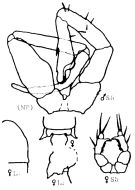 Issued from : K.A. Brodskii in Calanoida of the Far Eastern Seas and Polar Basin of the USSR. Opred. Fauna SSSR, 1950, 35 (Israel Program for Scientific Translations, Jerusalem, 1967) [p.288, Fig.196] . As Eurytemora kieferi, After Smirnov, 1931. Female (from Western shore of Vancouver Island): La, head; posterior part of thoraic segment (dirsal and lateral); S5, P5. Male: S5, P5.
|
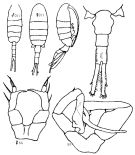 Issued from : K.A. Brodskii in Calanoida of the Far Eastern Seas and Polar Basin of the USSR. Opred. Fauna SSSR, 1950, 35 (Israel Program for Scientific Translations, Jerusalem, 1967) [p.287, Fig.195]. As Eurytemora thompsoni. Female (from Bering Sea): habitus (dorsal and lateral right side); urosome (dorsal); S5, P5. Male: habitus (dorsal); S5, P5.
|
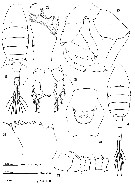 issued from : G.A. Heron in Crustaceana, 1964, 7 (3). [p.207, Figs.19-26]. Female (from Kivalina Lagoon, NW Alaska): 19, habitus (dorsal); 20, genital segment (ventral); 21, Md (cutting edge of gnathobase); 22, P5. Male: 23, habitus (dorsal); 24, right A1 (segments 8-14 with detail of spines); 25, P5 (posterior); 26, detail of apex of left exopod of P5 (anterior).
|
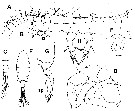 issued from : J.-M. Brylinski in Cah. Biol. Mar., 2009, 50. [p.254, Fig.2]. Female (from Dunkirk harbour): E, habitus (dorsal); F, detail of genital segment (ventral); G, urosome with spermatophore (sp) (lateral); H, P5. Male: A, right A1; B, detail of segments 8-12 with spines; C, urosome; D, P5 (posterior).
|
 issued from : G. Harding in Key to the adullt pelagic calanoid copepods found over the continental shelf of the Canadian Atlantic coast. Bedford Inst. Oceanogr., Dartmouth, Nova Scotia, 2004. [p.19]. Female & Male. L = left leg; R = right leg.
|
 Issued from : M.S. Kos in Zoological Institut RAS, St. Petersburg, 2016, 179, [p.58, Fig.25]. Eurytemora americana female (from the Bering Sea).
|
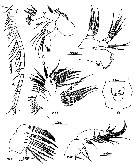 Issued from : M.S. Kos in Zoological Institut RAS, St. Petersburg, 2016, 179, [p.59, Fig.26]. Eurytemora americana female (from the Bering Sea). Gs = genital segment (ventral view).
|
 Issued from : M.S. Kos in Zoological Institut RAS, St. Petersburg, 2016, 179, [p.60, Fig.27]. Eurytemora affinis male (from the Bering Sea). np = right.
|
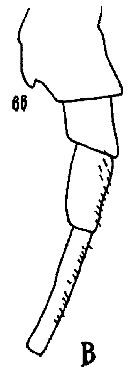 Issued from : M.S. Kos in Field guide for plankton. Zool Institute USSR Acad., Vol. II, 1976. Female: B, abdomen (lateral, left side).
|
 Issued from : S.I. Dodson, D.A. Skelly & C.E. Lee in Hydrobiologia, 2010, 653. [p.141, Table 2]. Descriptions of North American species of Eurytemora from Alaska. PX1: indicates the first (basal ) exopodal segment of P5.
| | | | | Compl. Ref.: | | | Wilson, 1932 (p.24); Deevey, 1960 (p.5, Table II, fannual abundance); Faber, 1966 (p.191: Rem.); Frolander & al., 1973 (p.277, annual cycles); Peterson & Miller, 1977 (p.717, Table 1, seasonal occurrence); Knatz, 1978 (p.68, Table 1, abundance, %); Tremblay & Anderson, 1984 (p.6, Rem.); Marcus & al., 1994 (p.154, Rem. p.157); Madhupratap & al., 1996 (p.77, Table 2: resting eggs); Mauchline, 1998 (tab.40, 47, 61); Pinchuk & Paul, 2000 (p.4, table 1, % occurrence); Biancalana & al., 2007 (p.83, Tab.2, 3); Darnis & al., 2008 (p.994, Table 1); Berasategui & al., 2009 (p.82); Brylinski, 2009 (p.253, Tab.1); DiBacco & al., 2012 (p.483, Table S1, ballast water transport); Menéendez & al., 2012 (p.389, Table 1: seasonal abundance); Menéndez & al., 2012 (p.11, variability vs physical processes); Berasategui & al., 2012 (p.380, egg morphology vs seasonal variation); Fernandez-Severini & al., 2013 (p.1495, heavy metals concentrations); Baumgartner & Tarrant, 2017 (p.387, resting eggs, Rem.) | | | | Loc: | | | Arct., SE Beaufort Sea, North America, Pettaquamscutt estuary, Navesink River estuary, Delaware Bay, Chesapeake Bay, Bay of Fundy, Nova Scotia, G. of St. Lawrence, Iceland, English Channel, Dunkerque Harbour, Strait of Dover, British Columbia, San Juan Is., Oregon (off Newport), Yaquina Bay, NW Pacif., Kamchatka, Bering Sea (also western neritic), N Okhotsk Sea, S Sakhalin, Argentina (Bahia Blanca), Ushuaia | | | | N: | 33 | | | | Lg.: | | | (22) F: 1,85-1,6; 1,6-1,14; M: 0,95-0,75; 1,05-1,02; 1,6; (564) F: 1,58-1,2; M: 1,43-1,22; (565) F: 1,82-1,11; M: 1,53-1,04; (566) F: 1,75-1,17; M: 1,7-1,05; (571) F: 1,58-1,35; M: 1,43-1,22; (846) F: 1,42-1,16; (1220) F: 1,14-1,85; M: 0,75-1,70; (1232) F: 1,35-1,85; M: 0,75-1,43; {F: 1,11-1,85; M: 0,75-1,70} | | | | Rem.: | Incomplete data. Littoral: brackish; in pools not connected with the sea (near Lancing, Sussex)
This species observed in Argentina, could have been introduced by ships.
For Brylinski (2009, p.255) this species resent in the wet docks of Dunkirk harbour (salinity < 31 p.1000) was probably imported in from bakllasts water tankers.
After Heron & Damkaer (1976, Table 2) ratio anal somite/uropod (= caudal rami) 4/7; with metasomal wings in female, not in male. | | | Last update : 17/09/2020 | |
|
|
 Any use of this site for a publication will be mentioned with the following reference : Any use of this site for a publication will be mentioned with the following reference :
Razouls C., Desreumaux N., Kouwenberg J. and de Bovée F., 2005-2025. - Biodiversity of Marine Planktonic Copepods (morphology, geographical distribution and biological data). Sorbonne University, CNRS. Available at http://copepodes.obs-banyuls.fr/en [Accessed June 04, 2025] © copyright 2005-2025 Sorbonne University, CNRS
|
|
 |
 |












